Debra Wink is a microbiologist who’s work I’ve used before on this site when explaining what’s happening inside a Sourdough Starter here. Without Debra’s work I would still be in the Dark Ages, continuing to think incorrect facts about starters such as establishing a starter is a battlefield between good and bad bacteria or that wild yeast is there from the beginning. Debra also clarified and dispelled old myths for example that San Francisco Sourdough was unique because it contained Lactobacillus Sanfranciscensis, therefore one wouldn’t be able to reproduce it in other parts of the world, but in fact L. Sanfranciscensis is one of the most commonly found strains in starters maintained at ambient temperatures all around the world.
Debra looked into the research carried out over the years on sourdoughs and put it in a digestible form for us on The Fresh Loaf forum, if you search through that site on her contributions you’ll see how extensive it is. But don’t think of Debra a mere interpreter of research papers as that’s greatly undervaluing her contribution to our further understanding of a sourdough culture, she has carried out original work herself: The Pineapple Juice Solution.
Debra along with other bakers on the King Arthur Baking Circle forum in 2002 were discovering for unexplained reasons some sourdough starters would not follow the expected pathway of growing wild yeast cultures by the end of the first week, instead they appeared to show early signs of great activity on day two only to be followed by days of dormancy. It was this reoccurring pattern with some starters which made Debra’s curiosity take hold, and her subsequent investigations led to some fascinating discoveries in the birth of our starters. You can read the details of her experiments here part I and part II here. Debra discovered the gas producing bacteria on day 2 in these problematic starters was Leuconostoc citreum, and the lab she had also asked to investigate the starters found there was Aerococcus and to a lesser extent Enterobacter cloacae.
The beautiful outcome of this research Debra carried out wasn’t only identifying these strains of bacteria, it was the discovery of how in the process of the starters one bacteria would take hold and live and then drop off as acidity levels increase, making way for a different bacteria to have its turn and this went on until the environment was perfect for wild yeast and the lactic acid bacteria to appear and dominate.
Debra was kind enough to answer some questions of mine a few months back and for those who have read her work on the Fresh Loaf forum will see how this refers back to that work.
Q: Does this mean these LABs that produce carbon dioxide and/or alcohol also contribute to dough rising in a sourdough? as well as the wild yeast? If that’s the case my next question would be if these LABs didn’t do some rising, does that mean the “rising” of the loaf would be decreasing with just the wild yeast producing the gases? or is the contribution from the LABs producing gases so small it wouldn’t matter if they do or not?
Debra: I think their contribution depends a lot on which LAB are present. In most traditional (type I) sourdoughs, the LAB tend to be all heterofermentative. You may need to review the article on Lactic Acid Fermentation here, but the obligate heterofermenters have to follow the heterofermentative pathway. When they are fermenting a 5-carbon sugar like xylose or arabinose, there is no extra carbon to get rid of, so they don’t make CO2. When they are fermenting 6-carbon sugars like glucose, sucrose or maltose (fructose is generally saved for a special function), they have to first turn it into a 5-carbon sugar to fit the pathway. That means kicking out one of those carbons, which they do by turning it into CO2. These LAB have the potential to create a fair amount of CO2 because they are fermenting mainly maltose.
On the other hand, the facultative heterofermenters (meaning they follow the heterofermentative pathway under certain conditions, but not others), do something different. When fermenting 5-carbon sugars, again, no CO2 for the same reason as above. And in general, when fermenting maltose or other 6-carbon sugars, they use the homofermentative pathway—also no CO2, because this pathway needs all six carbons. The only time they produce CO2 is when there is fructose, oxygen, or another substance available they can use as a co-cubstrate. In that case, a 6-carbon sugar will be fermented heterofermentively, and a CO2 will be cast off to cut it down to a 5-carbon sugar. These LAB produce very little CO2 in bread dough, because they are mostly using the homofermentative pathway.
So perhaps the biggest factor is the species of LAB that are present. But also, the temperature plays a big part as well. LAB tend to ferment fastest in the 90′s, too warm for yeast to do well. I would say most breads are leavened mostly by the yeast, however there are some cases where LAB contribute a fair amount. San Francisco sourdough for example. The starter and process studied in the 1970′s by Sugihara and Kline was a mother dough consisting of only one LAB—L. sanfranciscensis—an obligately heterofermentative bacterium. The process was carried out very warm (75-80ºF for the mother dough, 85-90ºF for the final dough).
Q: In your work that I read this week you mention how after looking into what happens in the very beginning of the starter with the microbes from day one, how one strain starts then dies changing the environment and the next strain take up residence and they die until ideally you end up with the yeast & LABs, you describe at the end how this wasn’t a battle field of Good v. Evil microbes as we use to think but more of a relay race. I thought this was extremely well put.
Debra: Thanks. They don’t necessarily die though. They really just stop growing, and then get discarded at feeding time. They fade away because they are no longer rebuilding their numbers in between refreshments, and are flushed out until they are reduced back to whatever number gets added each time you feed, whether they come from the flour, the air, your skin, or whatever else comes in contact with it. I think it’s important to remember that the organisms are there, viable but not necessarily active, not just when we’re making sourdough starters from scratch, but all the time.
Q: Reading McGee’s entry on dough it says, “Yeast produce carbon dioxide most rapidly at around 95F/35C but they also produce more noticeable quantities of sour and unpleasant-smelling by-products.” There is no mention ever of any LABs in long fermentation of yeast doughs, he attributes completely the sour smell as a by-product of fermented yeast.
Debra: Wild sourdough yeast produce CO2 most rapidly in the mid-80′s (27˚C), hardly any in the mid-90′s (32˚C) or above, so I think he must be referring to baker’s yeast here, and I don’t know if those numbers are accurate or not. But it’s easy to forget that even in yeasted breads, yeast are not the only microorganisms present.
Q: This has made me think of a battle field in an established sourdough starter between wild yeast & LABs and the more acidic your starter is the LABs are thriving and the wild yeast are dying. The reason I bring this up is because it ties a little bit into what I say above…as the LABs increase in a starter some of these will be gas producing ones but obviously not in quantity enough to raise a loaf….old unrefreshed starters produce flat loaves…so I discovered in the beginning of learning sourdough.
Debra: LAB are actually more sensitive to low pH than yeast are. But yeast are sensitive to acetic acid, and so they are inhibited by LAB in that way. LAB can easily get out of hand in an underfed starter, while yeast become more and more sluggish.
Q: I mention in my blog post where I discuss your work, that in the Advance Bread & Pastry book it says wild yeast & bacteria are mainly introduced into the starter from the flour
Debra: The first organisms to establish in a new starter do come from the flour, but in the long run it isn’t clear where some of them came from in “nature.” Several species discovered in the last decade have only been found in sourdough starters, period. They don’t ride in on the flour. And some sourdough lactobacilli have also been isolated from the GI tract of a warm-blooded animal, such as a pig, or a mouse, etc. But as I pointed out in my writings on biodiversity, this is far from an easy science, and previous information becomes outdated at a certain point.
” Bacteria growing much more rapidly than yeast always outnumbers them.”
Debra: Not necessarily. Bacteria do grow more rapidly, but don’t always outnumber yeast. One study I’ve read (the Belgian study that I wrote about) found that “In general, the yeast-LAB ratio varied from about 1:10 to 1:100, except for samples …, where the ratio was approximately 1:1, and samples …, where the ratio varied from 1:10,000 to 1:100,000.” This ratio is influenced by a number of factors—particularly temperature, hydration, feeding rate and frequency. You have a lot more control over the balance and ecology of your starter than you might think.
Makes me wonder where along this process are the gas producing bacteria most active, at the beginning of introducing new flour to the starter or towards the other end when the wild yeast cells start to die?
Debra: LAB have a longer lag time than yeast, meaning it takes them longer to start growing after refreshment than yeast do. That’s how the yeast keep pace with them……. in a well-fed starter. Because you refresh according to rise and fall which is mostly determined by yeast activity. If you let it continue past that point, the bacteria will overtake. It’s kind of a game of leap-frog (are you guys familiar with that children’s game over there ![]() First the yeast start growing. Then at some point later, the bacteria start growing (and they grow faster). The yeast stop growing, while the bacteria continue on for a time (sometimes quite a while). If you refresh when the yeast stop growing, you stop the bacteria, and start the cycle over. As they say, timing is everything.
First the yeast start growing. Then at some point later, the bacteria start growing (and they grow faster). The yeast stop growing, while the bacteria continue on for a time (sometimes quite a while). If you refresh when the yeast stop growing, you stop the bacteria, and start the cycle over. As they say, timing is everything.



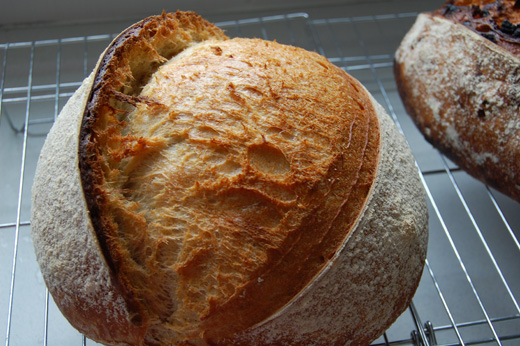
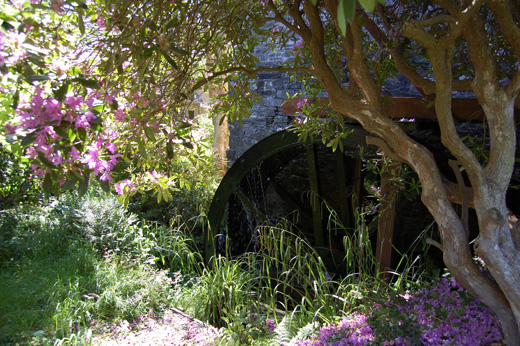
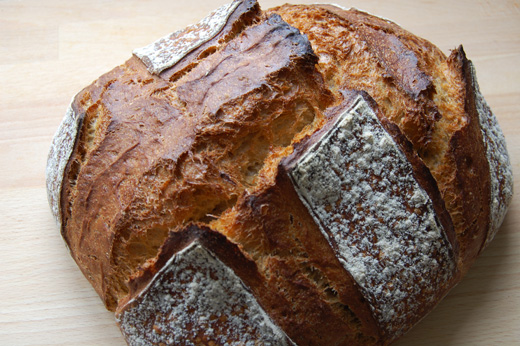



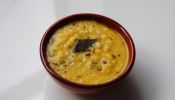


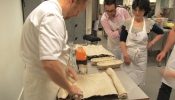














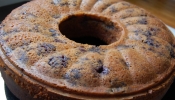


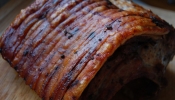







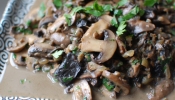




{ 4 comments }
hello and congratulations on your research and scholarship – it’s very interesting stuff. i’m new to serious bread baking and i’m following the very simple instructions from Matthew McDonald regarding levain that appear in Thomas Keller’s Bouchon Bakery book. the last thing you may want to talk about would be a levain problem, but i’ve read reinhart, sourdoughhome.com, i’ve talked with King Arthur Flour, I’ve read your info and i’m still stuck. the problem: my starter “starts,” behaves like a champ, doubling in volume at each feeding which occurs every 12 hours, then after 3 days it goes “dormant” whereby activity dramatically decreases and it loses structure, becoming a soup. continued feedings do nothing to generate activity. i’ve left it alone, just stirring 2 or 3 times a day, no feedings, and in 5 days i get renewed yeast activity – frothy bubbles and yeasty clumping as if i’ve finally got the good yeast going – only to “kill” everything off again when i feed it. of note: i’ve begun from scratch twice: once with just flour + water, and once with orange/pineapple juice + flour – both times i had the same doubling volume for 3 days, fed every 12 hours, good activity within hours of each feeding, then after day 3, a sleepy soup with just a handful of pencil-tip-sized bubbles. the aroma is always of apples and mildly of yeast. i tried feeding with whole wheat flour and obtained the same soupy, drowsy culture within 12 hours. i haven’t bought a starter from King Arthur because i’m afraid i’ll just kill it after 3 days and i’d like to know what’s actually happening. thanks in advance for any help you could provide.
Keith – it’s impossible for me to tell over the net, I can only guess. I take it you’re talking about having problems with starting a sourdough starter? And not of continuing to maintaining one once it has been established? If this is the case then as my post says, from what Debra had tested under the microscope it may be your starter was delayed by having a different strain of LAB attack it in which case carry on going for two weeks feeding it once a day and then see if you have any activity. When my starters were attacked by some kind of strain it took 10-14 days to really get it back to normal again. We just have to give the good strains of bacteria a fighting chance to come back and thrive or in your case to start-up.
I’ve used white wine vinegar as well as juice with a couple of starters, depending on what I had around at the time.
Presumably it’s increasing the acidity of your flour/water mix that is the critical step, rather than the flavour of the juice you might use.
Barry – yes acidity is needed for lowering the pH of the starter in the initial days that’s why pineapple is important as it has enough acidity. Personally I wouldn’t use vinegar.